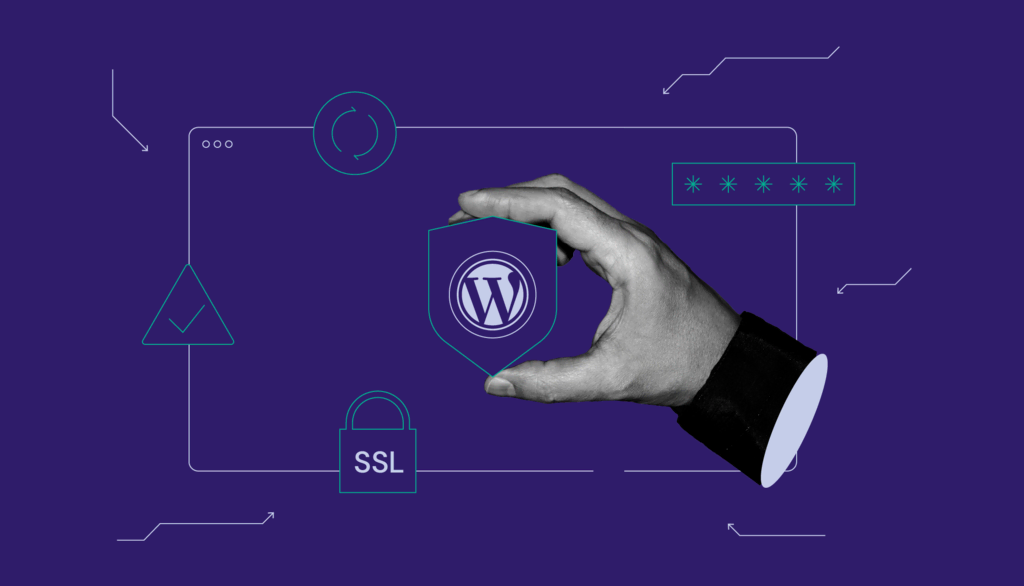You wouldn’t leave your house’s security unattended, would you? The same goes for your business’s website. Becase the stats from Forbes showed more than 70% increase in data-breaching cyberattacks, costing the victims more than $4 million. This speaks for itself that people are not savvy enough when it comes to protecting their data online.
Whether it’s a profile, business account, or an entire website, you need to ensure that all ends remain secure so that you don’t become a victim of a cyberattack. And if you’re running your website on WordPress, you need to be even more vigilant.
Using outdated security measures cause WordPress to face more than 80,000 cyberattacks every minute, which is quite alarming for all users of the platform. Hence, in order to protect your WordPress site from hackers, you need to fortify its security and effectively monitor its performance.
Fortunately, we’re sharing a complete guide that includes top security tips to protect your WordPress site from hackers. We’ve compiled a list of potential security threats to WordPress sites, essential security practices, and the ways to monitor and audit these measures. So, let’s get down to them right away:
Security Threats to WordPress Websites
Security threats to WordPress are dangerous since they not only render the site useless but also cause data breaches, affecting the users connected to the website. Here are the threats to WordPress cybersecurity that you should look out for:
- Malware Infections
Malware are small viruses that exploit the loopholes in the system. Once a security loophole is identified, it then infects the website/system through it, rendering it inoperable or affecting the resources.
A malware infection can occur on WordPress or any website when a user visits or opens a malicious link. This can be through foreign websites, user-access requests, or anything online.
- Brute Force Attacks
Related to password breaches, brute-force attacks are some of the most common ways hackers infiltrate any website or user profile. It involves continuous attempts to crack a login password.
If the password targeted is weak (doesn’t involve the prescribed security), then a brute-force attack can become successful in no time. The success of a brute-force attack isn’t the question but the time. It can take less than a minute or more than a year for this attack to crack any password.
- SQL Injection Attacks
SQL is a preferred language for WordPress database management. However, hackers use SQL commands (hence the name SQL Injections) to access the data stored or even hidden in the databases maintained using SQL.
The SQL injection attack uses brute insertions of SQL commands in any form of input option where the command then executes to allow unauthorized access.
- Cross-Site Scripting
When targeting a webpage functionality, hackers use cross-site scripting to place malicious codes there. This is done with the plugins used on WordPress. Hackers may place such a code in the plugins.
When you or anyone else installs and runs the plugin, the malware gets access to the website’s front end. With this access, the hacker may try to sabotage the functionality of the website or even acquire information from the users via input forms that they don’t even know about.
- DDoS Attacks
The Distributed Denial of Service (DDoS) although hasn’t affected on a large scale, with over 95% of the network layer remaining safe, it’s still notorious for the havoc it wrecks. The attack floods the servers with traffic, preventing actual users from accessing the website.
AWS, Google, GitHub, etc. have experienced this attack where numerous users were affected.
Cause of Weak WordPress Security
There can be several causes behind weak WordPress security. We’ve listed some of the most common issues below:
- WordPress Core Issues
WordPress core consists of developer and third-party sourced files. Like any platform or app, these files must remain updated so that the performance and security aren’t affected. Failure to update core files leads to their vulnerability, performance issues, and ultimately, cyberattacks.
- Poorly Configured CDN
A Content Delivery Network or CDN server needs to be configured before it’s deployed in any network. However, with poor configuration, hackers can easily intercept the server and cause complete website failure.
- Lack of 2FA
2-factor authentication or 2FA is a great defense against unauthorized access. The hackers can use brute force attacks to guess the password, which means that without 2FA, the website and user profiles are prone to cyberattacks.
- Poor User Control
With a great number of users, the administrators need to ensure that every user is assigned a role of access. When this is overlooked, users can take advantage or the hackers can infiltrate profiles with more access privileges, causing a threat to the integrity of your WordPress website.
- Outdated or Malicious Plugins
WordPress uses third-party plugins to improve its performance. However, when these plugins remain outdated, they can be susceptible to cyberattacks. Moreover, some hackers may create plugins with malicious links that can sabotage the website when they’re installed.
- Unrestricted XML-RPC Protocol
The XML Remote Procedure Call or RPC protocol is used for communication between a Universal Robot (UR) controller and external applications using HTML code. The XML-RPC is still a default mode used for communication even though REST API was introduced. Keeping the XML-RPC unsupervised leads to hackers infiltrating the network and initiating DDoS attacks.
- Credit Card Skimming
The act of stealing credit card information using malicious JavaScript is known as credit card skimming. Without proper security or monitoring tools, hackers can infiltrate the system, place the script, and then steal such sensitive information without you knowing about it.
- SEO Spam
Ensuring that the latest SEO practices are met, developers often overuse SEO practices, enrich keywords, or use links more than the recommended count. However, hackers can attempt to place malicious files within the links or even link to your website to boost their rankings.
- Bad File Inclusions
File inclusion is a process where your website imports files from a remote server controlled by the hacker.
In most cases, a hacker launches a file inclusion attack where it forces the website to import files from its controlled server. These are malicious, once they’re included in the website script, the files can sabotage their workability.
Essential Security Practices to Prevent WordPress Cyberattacks
With so many security threats, you must make strenuous efforts to protect your WordPress website from hackers. Here are some methods to get started with:
**Add image/ icons for every solution**
- Keep Core Files Updated
Updating WordPress core files will keep hackers at bay. Whenever a patch update is available, ensure that you’re installing it to avoid starving the core from security-proofing. This would also mitigate any loopholes that hackers can exploit to enter the core.
- Update Plugins
While you’re updating the core, ensure that any plugin update is also installed. Similar to the core, pending plugin updates can create security loopholes that hackers can exploit. In addition, ensure that you’re not installing any unnecessary plugins for the website.
Old, unused plugins from unverified sources are a threat to the security of your website, which is why you need to keep a solid eye on your plugin pool.
- Use Strong Passwords
This is a no-brainer; however, most security attacks are initiated due to weak passwords. A simple way of strengthening your passwords is to add:
- Upper and lower case alphabets
- Use numbers
- Use special characters such as #$%@!
Common examples can be ‘Sim908@##1’, or ‘Lia444@stree!’.
- Add 2 Factor Authentication
In addition to strong passwords, make sure to add 2-factor authentication (2FA).
In most cases, 2FA can help mitigate any chances of a cyberattack where the password has been breached. However, ensure that 2FA leads to centralized security checks, which can authenticate the access or otherwise block the user.
- Create a Backup
All in all, you need to ensure that your data remains safe. Hence, making regular backups for the website is crucial. It’s highly recommended to make backups on a different server, in the event that the website servers are compromised, it can be restored easily.
- Get a Reliable Internet Connection
Make sure you’re using a safe internet connection for your WordPress website. A shared connection can create a chance for malware to infect all the connected devices. We recommend getting internet from reliable providers such as Xfinity internet or any reputed ones near you.
- Use WAF
A Web Application Firewall or WAF is like a guard at the door. With the WAF plugin, you can easily inspect incoming traffic from the web to your website. Resultantly, any shady visitors from unapproved websites will be blocked, protecting your website. WAFs are easy to maintain and can be sourced from reputed firewall and security providers.
- Choose a Reliable Host
If you’re not vigilant about the hosting server where your WordPress website is running, you’ll regret it later. Choosing a reliable hosting service provider is important for your WordPress website.
A secure hosting server implements high-end security measures on its own end. Hence, any cyberattacks will be prevented and your WordPress website will remian safe.
- Ensure SSL/HTTPS
Buying an SSL certification for your WordPress website is also one of the best ways of securing it. Generally it’s essential for any online business to set up SSL for their website. Even though it’s not enough, it’s still a way of adding additional security.
If you’re buying hosting services, you can get an SSL service included in your plan since many do offer the service. Otherwise, you can find them online from SSL certificate providers.
- Disable File Editing
File editing enables anyone accessing your website to make changes to the files. Hence, it’s quite important that you:
- Define initial roles for the users
- Disable file editing for different users:
- Open wp-config with admin access
- In its php file, type in ‘ define( ‘DISALLOW_FILE_EDIT’, true ); ’
- Log Out Idle Users
There’s a possibility of a brute-force entry through idle user accounts. Hence, you should ensure that all idle users are logged out so that such an instance is mitigated. Here’s how to do it:
- Log in as admin and head to Logged Users via WP Activity Log
- Click Users Session Management
- You can choose individual users or select all to implement the changes
- Click Terminate Idle Sessions
- Set the time for idle users before session termination
- Save your entry
- Block Hotlinking
Although it’s not a security threat, hotlinking does create a vulnerability for your WordPress website. In most cases, other website users may use images or content from your site and place them on theirs.
However, in case their website gets any hit, cyberattack, or flagged, the content will be too, and search engines can track the image to your website, flagging it as well. What you can do is add protective watermarks that can protect your content from hotlinking. You can find several plugins online that you can install and minimize hotlinking.
- Edit Login Page URL
An easy way of preventing hackers from even accessing your website is changing the login page URL. The ‘wp-login.php or wp-admin allows users to access the login page; however, if you:
- Edit the .htaccess file from WP Root
- In RewriteRule ^mylogin$ https://%{SERVER_NAME}/wp-login.php?key=123&redirect_to=https://%{SERVER_NAME}/wp-admin [L], replace mylogin with a new URL slug and 123 with another string.
- Save your entry
You can change the URL to your WP’s login page.
Also Read: Customizing a WordPress Website


